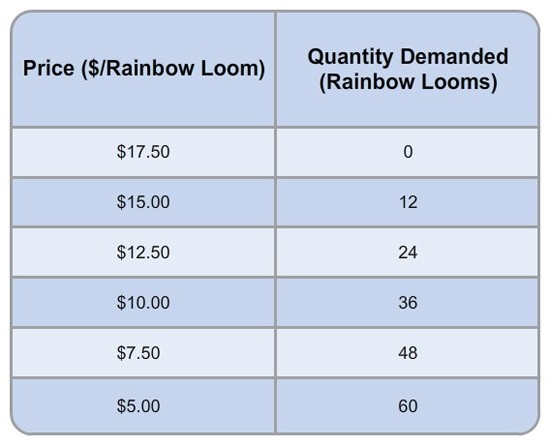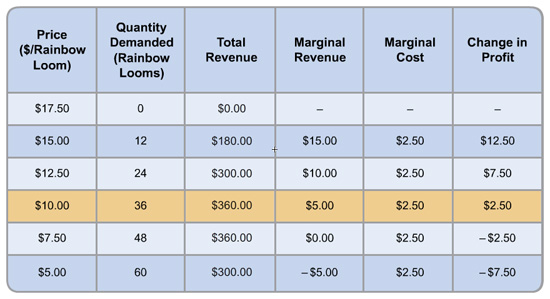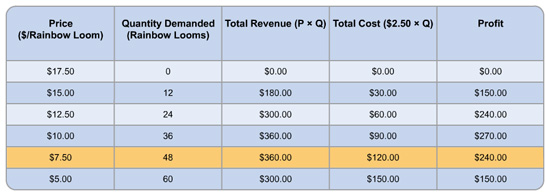Work It Out
Chapter 15
Question 1 of 3
Work It Out
Chapter 15
true
true
You must read each slide, and complete any questions on the slide, in sequence.
Consider the following demand schedule for Rainbow Looms. Assume that the marginal cost of producing a Rainbow Loom is a constant $2.50. Note that when marginal cost is constant, average cost is constant. Fixed costs are assumed to be zero.

Rainbow Looms would be produced under a Rainbow Loom monopoly.
2:17
Correct! The columns in the below table were calculated using the following formulas: Total revenue (TR) = P × Q and Marginal Revenue (MR) = ∆TR/∆Q. Profit increases from additional sales as long as MR > MC. From the table, this occurs at a quantity of 36, which is where profit would be maximized. Beyond 36 units, where MR < MC, profit would decline as seen in the "Change in Profit" column.


Sorry! Think about whether the quantity that you chose maximizes profit. To review how to determine the output that will maximize profit, please see the section “Cartels?"
Question 2 of 3
If instead of a monopoly, a two-firm cartel controlled the Rainbow Loom market, each firm would want to produce Rainbow Looms in order to maximize industry profits.
Correct! If there is a two-firm cartel, they will attempt to act as a monopoly. In Question 1, we determined that the monopoly production level would be 36, so each member of the cartel would produce 18, or half the monopoly amount.
Sorry! Consider how the cartel would behave given that it is made up of the only two firms in the industry. To review how to determine the output that will maximize profit, please see the section “Cartels?”
Question 3 of 3
It possible for one of the two firms in the cartel to earn higher profits by producing more than the industry profit-maximizing quantity calculated in Question 2.
3:43
Correct! If there is a two-firm cartel, one could attempt to cheat and produce more than the cartel amount of 18 per firm. Say that 1 firm cheats and produces 12 additional units so that total production is now 48. From the table, we can see that this would push the price down to $7.50. Prior to the firm cheating, each firm produced 18 units and total revenue was $360, so each firm's total revenue equaled $180. After the firm cheats, the total revenue for the cheating firm will be $225 ($7.50 × 30) with total costs of $75 ($2.50 × 30), leading to profits of $150 ($225 − $75). The firm that does not cheat earns total revenue of $135 ($7.50 × 18) with total costs of $45 ($2.50 × 18), leading to profits of $90 ($135 − $45). Thus the cheating firm's profit will rise and the non-cheating firm's profit will fall.


Sorry! Think about whether there is an incentive to cheat on the industry profit maximizing level of production determined in Question 2. To review please see the section on "The Incentive to Cheat.”